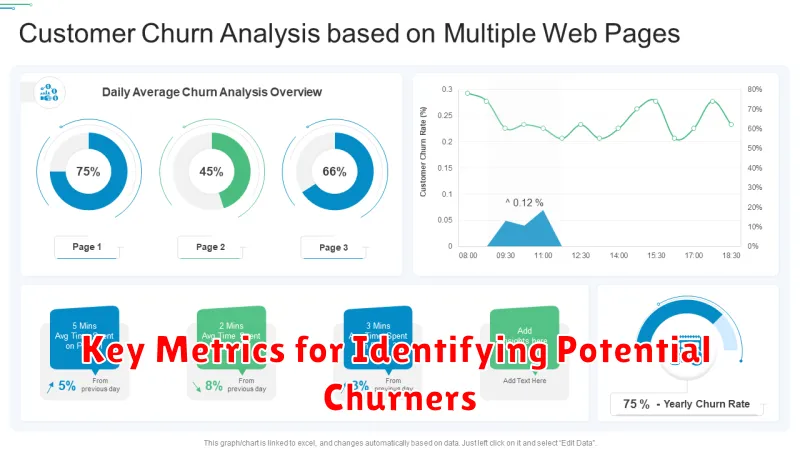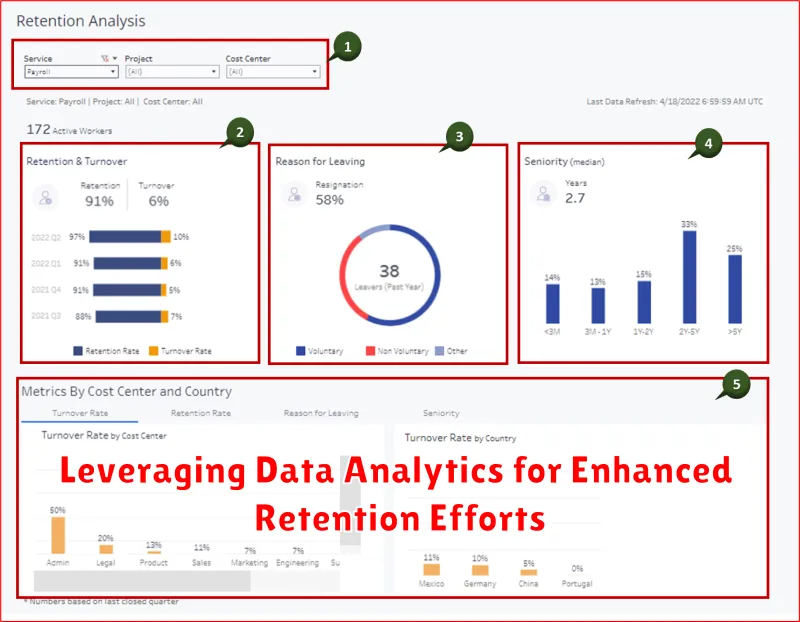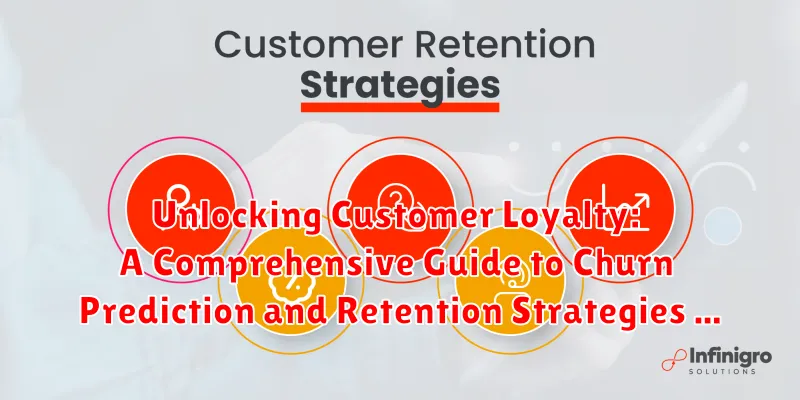In today’s competitive market, understanding and minimizing customer churn is paramount for sustainable business growth. Acquiring new customers is significantly more expensive than retaining existing ones. This article, “Unlocking Customer Loyalty: A Comprehensive Guide to Churn Prediction and Retention Strategies,” provides a data-driven approach to proactively identifying customers at risk of leaving and implementing effective strategies to keep them engaged. Globally, businesses across diverse sectors, from e-commerce and telecommunications to subscription services and financial institutions, grapple with the challenges of customer retention. This guide offers actionable insights applicable across various industries to improve customer lifetime value and boost profitability.
This comprehensive guide explores the critical aspects of customer churn prediction, including the underlying causes of customer attrition, the key metrics to track, and the application of advanced predictive modeling techniques. We delve into various churn prediction models, such as machine learning algorithms like logistic regression, support vector machines, and random forests. Moreover, it provides an in-depth analysis of effective customer retention strategies, encompassing personalized communication, proactive customer service, loyalty programs, and targeted marketing campaigns. By implementing the strategies outlined in this guide, businesses can significantly reduce churn rates, enhance customer loyalty, and foster long-term relationships with their valuable customers.
Understanding Customer Churn: What It Is and Why It Matters
Customer churn, also known as customer attrition, refers to the phenomenon of customers discontinuing their relationship with a business or service. This can manifest as cancellation of subscriptions, failure to renew contracts, or simply ceasing to purchase products or services.
Understanding churn is critical for several reasons:
- Revenue Loss: High churn rates directly impact revenue streams, making it harder to achieve sustainable growth.
- Increased Acquisition Costs: Replacing lost customers is often more expensive than retaining existing ones.
- Reputational Damage: High churn can signal underlying problems with product quality, customer service, or overall satisfaction, potentially harming a company’s reputation.
- Impact on Profitability: The combination of revenue loss and increased acquisition costs significantly affects profitability and long-term business viability.
By actively addressing and mitigating customer churn, businesses can foster stronger customer relationships, improve financial performance, and build a more resilient and successful organization. Therefore, recognizing the signs and understanding the drivers behind churn are paramount to implementing effective retention strategies.
The Importance of Predicting Churn: Proactive vs. Reactive Approaches
Understanding the difference between proactive and reactive approaches to churn management is critical for fostering lasting customer loyalty. A reactive strategy addresses churn only after it has occurred, often involving damage control and attempts to win back lost customers. While necessary, this approach is costly and less effective than prevention.
A proactive approach, on the other hand, focuses on predicting which customers are likely to churn and intervening before they do. This involves analyzing customer data to identify warning signs and implementing targeted retention strategies. The benefits of a proactive approach are numerous, including reduced churn rates, increased customer lifetime value, and improved resource allocation. By anticipating churn, businesses can invest in preventative measures and cultivate stronger customer relationships. Ultimately, shifting from reactive to proactive churn management empowers organizations to build a more sustainable and loyal customer base.
Key Metrics for Identifying Potential Churners

Identifying potential churners early is crucial for proactive retention efforts. Several key metrics can provide valuable insights into customer behavior and predict the likelihood of churn. These metrics can be broadly categorized into engagement metrics, satisfaction metrics, and economic metrics.
Engagement Metrics: These metrics track how frequently and deeply customers interact with your product or service. Examples include:
- Frequency of Use: A significant drop in usage frequency often indicates disengagement.
- Feature Adoption: Low adoption rates of key features may suggest customers are not realizing the full value of your offering.
- Website/App Activity: Reduced time spent on your website or app, or fewer pages visited, can signal waning interest.
Satisfaction Metrics: These metrics gauge customer satisfaction levels and identify areas for improvement. Key indicators include:
- Customer Satisfaction (CSAT) Scores: Low CSAT scores directly reflect dissatisfaction.
- Net Promoter Score (NPS): A decline in NPS suggests customers are less likely to recommend your product or service.
- Customer Effort Score (CES): High CES values indicate customers are experiencing difficulty using your product or service.
Economic Metrics: These metrics relate to the financial value customers bring to your business. Important indicators include:
- Average Order Value (AOV): A decrease in AOV can signal reduced spending.
- Purchase Frequency: Less frequent purchases suggest a potential decline in customer value.
- Subscription Downgrades: Downgrading to a lower-tier subscription often precedes complete churn.
By closely monitoring these metrics, businesses can identify at-risk customers and implement targeted retention strategies to mitigate churn.
Common Causes of Customer Churn: Addressing the Root Problems
Understanding the root causes of customer churn is crucial for developing effective retention strategies. Addressing these underlying issues proactively can significantly reduce churn rates.
Poor Customer Service
Inadequate or unresponsive customer service is a major driver of churn. Customers expect timely and helpful support when they encounter problems. Long wait times, unresolved issues, and rude representatives can quickly lead to dissatisfaction.
Lack of Engagement
Customers who are not actively engaged with a product or service are more likely to churn. Insufficient onboarding, lack of valuable content, and infrequent communication can all contribute to disengagement.
Price Sensitivity
If customers perceive that a product or service is overpriced relative to its value or compared to competitors, they may switch to a cheaper alternative. Sudden price increases without clear justification can also trigger churn.
Product Issues
Recurring technical glitches, usability problems, or a lack of desired features can lead to customer frustration and ultimately, churn. Failing to address product defects promptly can erode customer trust.
Competitive Offerings
A superior product or service offered by a competitor can entice customers to switch. Keeping abreast of the competitive landscape and continuously improving your own offerings is essential for retention.
Effective Churn Prediction Models: A Deep Dive into Techniques
Predicting customer churn is crucial for proactive retention strategies. Several sophisticated models can be employed to identify customers at high risk of leaving. Understanding the strengths and weaknesses of each model is essential for selecting the best fit for your business needs.
Common Churn Prediction Models
- Logistic Regression: A statistical model that predicts the probability of churn based on various factors. It’s interpretable and relatively simple to implement.
- Decision Trees: These models create a tree-like structure to classify customers based on a series of decisions. They are easily visualized and understood.
- Random Forests: An ensemble method that combines multiple decision trees to improve accuracy and reduce overfitting.
- Support Vector Machines (SVM): SVMs find the optimal hyperplane to separate churners from non-churners in a high-dimensional space.
- Neural Networks: Complex models that can learn intricate patterns in data. They often achieve high accuracy but require significant computational resources and data.
The choice of model depends on the complexity of your data, the desired level of accuracy, and the interpretability required for your business.
Implementing a Churn Reduction Strategy: A Step-by-Step Guide
Developing and executing a robust churn reduction strategy is crucial for maintaining a healthy customer base and ensuring sustainable business growth. This process involves several key steps, from identifying at-risk customers to implementing targeted interventions.
Step 1: Data Collection and Analysis. Begin by gathering comprehensive data on your customers, including demographic information, purchase history, engagement metrics, and support interactions. Analyze this data to identify patterns and trends that correlate with churn.
Step 2: Segmentation and Targeting. Segment your customer base based on churn risk and other relevant factors. This allows you to tailor your retention efforts to specific groups of customers, maximizing their effectiveness.
Step 3: Implement Retention Initiatives. Develop and implement targeted retention initiatives based on your churn prediction model and customer segmentation. Examples include:
- Personalized offers and discounts
- Proactive customer support and outreach
- Enhanced onboarding experiences
- Loyalty programs and rewards
Step 4: Monitoring and Evaluation. Continuously monitor the effectiveness of your churn reduction initiatives and make adjustments as needed. Track key metrics such as churn rate, customer lifetime value, and customer satisfaction to assess the impact of your efforts.
Personalization and Customer Experience: The Power of Tailored Interactions
In today’s competitive landscape, personalization and customer experience (CX) are paramount to fostering customer loyalty and reducing churn. Generic interactions are no longer sufficient; customers expect brands to understand their individual needs and preferences. This understanding allows for tailored interactions that resonate and build stronger relationships.
The Benefits of Personalized Experiences
A personalized approach offers several advantages, including increased customer engagement, improved satisfaction scores, and higher retention rates. By tailoring content, offers, and communication channels, businesses can create a more relevant and valuable experience for each customer.
Strategies for Implementing Personalization
Effective personalization requires a deep understanding of your customer base. This can be achieved through data collection, segmentation, and analysis. Key strategies include:
- Data-Driven Insights: Leveraging customer data to understand behaviors and preferences.
- Targeted Communication: Delivering the right message to the right customer at the right time.
- Personalized Offers: Providing customized promotions based on individual purchase history and interests.
- Proactive Support: Anticipating customer needs and offering assistance before issues arise.
The Role of Technology
Technology plays a crucial role in enabling personalization. CRM systems, marketing automation platforms, and data analytics tools empower businesses to gather insights, automate personalized interactions, and measure the effectiveness of their efforts.
Leveraging Data Analytics for Enhanced Retention Efforts

Data analytics plays a crucial role in bolstering customer retention. By analyzing customer data, businesses can gain invaluable insights into customer behavior, preferences, and pain points.
This information empowers companies to proactively identify at-risk customers and implement targeted retention strategies. For example, analyzing purchase history, website activity, and customer service interactions can reveal patterns indicative of potential churn.
Predictive analytics models, built upon historical data, can forecast which customers are most likely to churn. This allows for timely intervention, such as personalized offers, proactive support, or targeted communication.
Furthermore, data visualization tools help present complex data in an easily understandable format, enabling stakeholders to quickly identify trends and make informed decisions regarding retention efforts. By effectively leveraging data analytics, businesses can significantly enhance customer retention and foster long-term loyalty.
The Role of Customer Feedback in Preventing Churn
Customer feedback is an invaluable resource for preventing churn. It provides direct insights into customer satisfaction, identifies pain points, and highlights areas for improvement. Actively soliciting and analyzing feedback allows businesses to proactively address issues before they escalate into reasons for customers to leave.
Key strategies for leveraging customer feedback include:
- Regular Surveys: Implementing customer satisfaction (CSAT) and Net Promoter Score (NPS) surveys to gauge overall sentiment.
- Feedback Forms: Providing accessible feedback forms on websites and within products.
- Social Listening: Monitoring social media channels for mentions, comments, and reviews related to your brand.
- Direct Communication: Encouraging direct communication through email, phone, or chat for immediate feedback.
By analyzing collected feedback, businesses can identify trends, understand customer expectations, and implement changes to enhance the overall customer experience. This proactive approach is crucial in preventing churn and fostering long-term customer loyalty.
Measuring the Success of Your Churn Reduction Initiatives
Evaluating the effectiveness of churn reduction initiatives is crucial for ensuring a return on investment and continuous improvement. It involves tracking key performance indicators (KPIs) and analyzing their trends over time.
Key Performance Indicators (KPIs) to Track
- Churn Rate Reduction: The most direct measure of success. Calculate the percentage decrease in churn rate after implementing your strategies.
- Customer Lifetime Value (CLTV) Increase: Assess whether the initiatives have led to an increase in the average CLTV of retained customers.
- Retention Rate Improvement: Monitor the increase in the percentage of customers retained over a specific period.
- Customer Satisfaction (CSAT) Scores: Track changes in CSAT scores to understand the impact of initiatives on customer satisfaction.
- Net Promoter Score (NPS) Improvement: Analyze whether the initiatives have positively influenced customer loyalty and advocacy, reflected in NPS scores.
Regularly monitor these metrics and compare them to pre-implementation baselines. Use data visualization tools to present trends clearly and identify areas for further optimization. A/B testing different approaches can also help pinpoint the most effective strategies.

